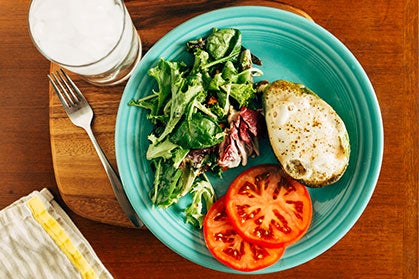New perk! Get after it with local recommendations just for you. Discover nearby events, routes out your door, and hidden gems when you sign up for the Local Running Drop.
Make smart choices to get the calories you need while avoiding post-workout binges

Photo by Flickr user J-nas / Creative Commons 2.0
I need help with portion control. I LOVE food! I try not to eat until I’m at top fullness and workout 30 to 45 minutes, five to six days a week. I would like some examples of smart portion sizes for my body so I have something to reference.
– Jenna Goodman, Bellingham, Washington
Portion distortion is a problem that continues to grow in the U.S. and beyond thanks to super-sizing at restaurants, value meals and the evolution of larger plates and serving utensils. Increasing portion sizes has contributed to unhealthy eating practices, the rise of obesity and, consequently, secondary diseases such as diabetes, heart disease and cancer.
Many people use the terms “portion” and “serving” interchangeably, but they are not the same thing. A portion is a subjective amount of food that you put on your plate or that you receive in a restaurant. A serving is a specific measurement of food. The United States Department of Agriculture established serving sizes to help determine portion-size guidelines and to standardize the amounts of different types of foods that are required for optimal health and weight control.
First, determine if your goal is to maintain, gain or lose weight. Then, for an estimate of how many calories and how many servings of each food group you should eat daily, go to ChoseMyPlate.gov, which offers recommended food plans.
Because calorie needs can change day to day depending on how long, how far or how intense you have worked out—and because measuring out servings can be, let’s face it, tedious—listen to your body’s hunger and satiety cues. By being mindful of your individual needs, you let your body become your innate calorie counter and you learn to determine appropriate portions that will satisfy your body and your mind.
It is all too common—especially after a long workout—for a person to eat three or four servings at a time. The trick is to keep your appetite in check. Depriving yourself of calories or certain foods early in the day can lead to binge eating later on; if you usually finish a run really hungry, try eating a snack or larger meal prior to the run. Keep healthy snacks like trail mix, whole fruit, nut-butter sandwiches and string cheese available in your car or backpack, so you can reach for them immediately post-run instead of being tempted by unhealthy offerings in vending machines or at the check-out counter.
Higher-mileage days and hard efforts require more calories for optimal recovery, but it is not a free-for-all. Choose nutrient-dense foods high in protein, good fats and ample carbohydrates to repair muscles and replenish glycogen stores. Putting high-quality fuel in your tank will help your engine be raring to go for the next tempo run, track session or trail adventure.
And remember—when you eat well-balanced meals and snacks that meet all of your energy and recovery needs, there is always room for a perfectly portioned piece of pie.
This is an installment in our online Ask the Dietitian column with Maria Dalzot, M.S., R.D., C.D.N., an avid trail runner. You can visit her blog at www.mariadalzotrd.com and submit your nutrition questions to nutrition@trailrunnermag.com.
